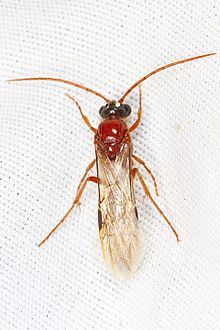

| Tiphiid wasps | |
|---|---|

| |
| Tiphia sp. | |
| Scientific classification | |
| Domain: | Eukaryota |
| Kingdom: | Animalia |
| Phylum: | Arthropoda |
| Class: | Insecta |
| Order: | Hymenoptera |
| Superfamily: | Tiphioidea |
| Family: | Tiphiidae Leach, 1815 |
| Subfamilies | |
| |
The Tiphiidae (also known as tiphiid wasps,[1] flower wasps,[2][note 1]ortiphiid flower wasps[3]) are a family of large, solitary wasps whose larvae are parasitoids of various beetle larvae, especially those in the superfamily Scarabaeoidea.[4] Until recently, this family contained several additional subfamilies, but multiple studies have independently confirmed that these comprise a separate lineage, and are now classified in the family Thynnidae.[5][6]
The females of some Brachycistidinae are wingless, and hunt ground-dwelling (fossorial) beetle larvae.[4] The prey is paralysed with the female's sting, and an egg is laid on it so the wasp larva has a ready supply of food. As some of the ground-dwelling scarab species attacked by tiphiids are pests, some of these wasps are considered beneficial as biological control agents.[7]
Tiphiid genera are classified as follows: [8][9][10]


| Tiphiidae |
|
|---|---|
| Authority control databases: National |
|
|---|